Content
- 1 Tomato varieties for growing on the windowsill
- 2 How to grow tomatoes in winter at home
- 3 Features of indoor tomatoes
- 4 The best varieties of indoor tomatoes
- 5 Ampel varieties
- 6 Agricultural technology for growing indoor tomatoes
- 7 Varieties that will "get along" in the house
- 8 Miracle on the balcony
- 9 Main growing conditions
Good day to readers and friends of the blog!
Today's article will be about growing tomatoes on a windowsill. Right now, in January, it is already possible to sow "home" tomatoes in order to bring down the planting fever and not rush to sow other crops that are too early to sow. Here are some varieties that can be successfully grown at home, like flowers!
Tomato varieties for growing on the windowsill
- Balcony miracle
- Bonsai,
- Baby,
- Pearl,
- Room surprise
- Golden bunch
- Pinocchio.
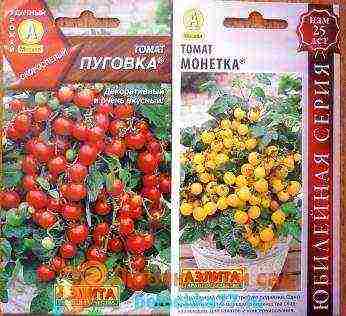 Tomato seeds
Tomato seeds
I will sow the varieties Monetka and Pugovka. You can see their description in the article "Tomato varieties for the Urals". And a description of other varieties and many other tomatoes for growing on the windowsill can be found in the article "Cherry Tomatoes - Varieties".
Now in more detail,
How to grow tomatoes in winter at home
Growing tomatoes is
- Seed preparation
- Soil preparation
- Sowing tomatoes
- Features of home care.
If we sow tomatoes in January, then in May we can already taste the harvest!
Seed preparation
To know for sure that the seeds will sprout, you can germinate them. There are interesting ways in the article "How to accelerate seed germination." Or just put them in a damp cloth in a warm place for a couple of days.
Alla Shirokova gives wonderful advice in the comments to the article "How to sow seeds with all my heart":
“In the book of Vladimir Megre“ Anastasia ”in the chapter“ The Seed-Doctor ”there is very good advice: before planting, take one or several small seeds in your mouth, keep in your mouth, under your tongue, for at least nine minutes. Then put your hands between two palms, hold them like this for about thirty seconds ……… Open your palms, and the seed that lies in your hand, you gently present to your mouth. And breathe out the air on the seed from your lungs. You warm it with your breath, and what is in you, the tiny seed will know ... And the seed will determine the moment of its rise. The planets will all help him in that! .. AND NO PRE-TREATMENT OF SEEDS !!!!
But, if you think that seeds should undergo traditional treatment before sowing, then take a look at the article "Treatment of seeds before sowing".
Soil preparation
- Tomatoes love fertile soil, with the addition of humus. Loose, permeable, moist.
- Homemade tomatoes need a lot of moisture, and the roots do not like stagnant water and dampness.
- You need to make good drainage in the pots.
- Choose a suitable pot size for space and nutrition. For low varieties (up to 50 cm), a 2-3 liter pot will be enough.
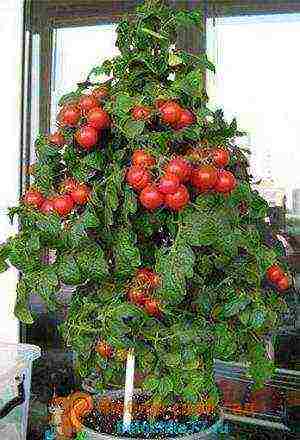 Let everyone have such a tomato on the windowsill!
Let everyone have such a tomato on the windowsill!
Sowing tomatoes
You can sow one seed at a time in a large pot (choose the largest ones). But it is better to sow a few seeds in a small container. Drizzle with warm water and cover with foil until germination. Then we remove the film and put it on a windowsill that is cool to 18 ° C so that it does not stretch.
We are waiting for two or three real leaves at the tomatoes. We choose the strongest from the seedlings and plant them. When transplanting, we deepen the plants to the very cotyledonous leaves, let more roots form. The plant will be more powerful.
Features of caring for a "home" tomato
- Watering... It is not necessary to water the tomatoes often. But make sure that the soil in the pot does not dry out. It is better to water twice a week, as it should, completely moistening the entire earthen ball, than to water a little every day - the soil inside may remain dry. If the air at home is very dry, spraying will help.
- Spraying... Tomatoes are not very fond of water on leaves in cold weather, but in an apartment in dry air you can spray them with water. Just do not do this during the flowering period.
- Supplementing.With such an early planting, the plants need to be supplemented. The days are still short, there is little light.
- Top dressing. While the plants are growing and gaining strength, they need nitrogen fertilizers. And during the period of formation and ripeness of fruits - potash.
Growing tomatoes on a windowsill in winter is no longer a secret for you.
If you have any questions about growing tomatoes at home, I suggest watching the video.
I tell you what came out of my growing tomatoes in 2015.
These are the bushes of the "Monetka" variety in the spring
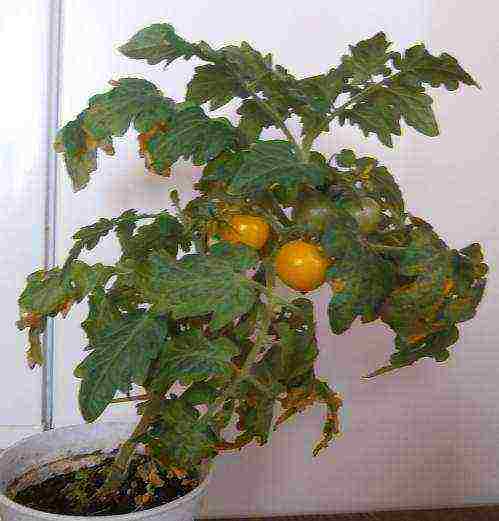 Tomato variety "Monetka"
Tomato variety "Monetka" First harvest!
First harvest!
The children really liked the tomatoes - I just took a sample and never saw them again. The younger one regularly checked the bushes and collected the crops.
Until late autumn, the bush was just as small and compact. New stepchildren were constantly growing and at once new tomatoes bloomed and sang. Nice sweet taste! They would still delight us with fruits even now, but we had a fire at home. Unfortunately, all the plants died, maybe something could have been saved - but we had no time for that.
I liked these little Coins. This year I will plant it again))))
And here is a photo of the Pugovka variety
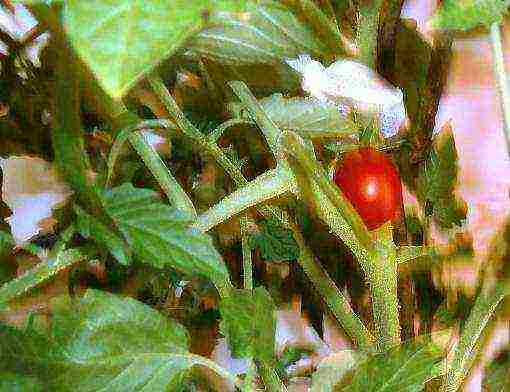 The first tomato
The first tomato
He became the only one that ripened on the bush))) My baby was harvesting green. Didn't let them sing at all! But like ordinary tomatoes, they ripened later.
And here are 2 bushes nearby
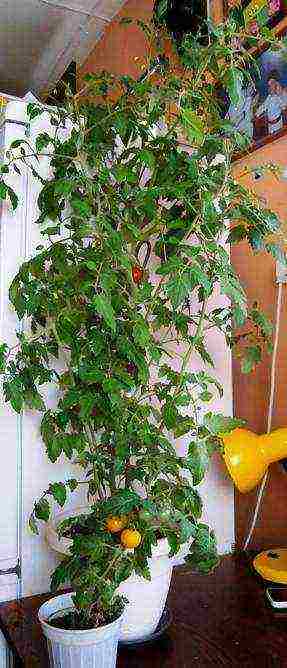 Baby and giant)))
Baby and giant)))
They are on the window
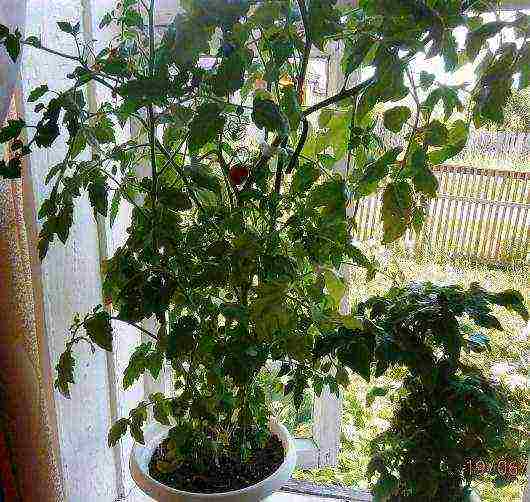 Coin and Button
Coin and Button
I was very surprised at the height of the bush - there were even thoughts that the seeds of the wrong sort were caught. But the stepsons also grew and bloomed constantly. He grew up to a meter and did not grow anymore.
You can read other interesting articles:
- Growing tomato seedlings at home
- About seedless tomato cultivation
- Growing cucumbers on the windowsill
- How to grow remontant strawberries from seeds
Best regards, Sophia Guseva.
Thanks to the efforts of breeders, tomatoes can be grown on the windowsill, and at any time of the year. There are many varieties that can produce good yields indoors. Growing them is no more difficult than ordinary tomatoes in the garden, moreover, they are not afraid of either drought or the Colorado potato beetle. To enjoy fresh tomatoes in the winter cold, you need to study all the nuances of such cultivation, but the most important thing is to choose the right variety.
Tomatoes on the windowsill in winter
Features of indoor tomatoes
Indoor conditions differ significantly from those in the garden, so not every variety of tomatoes will be able to grow and bear fruit normally indoors. Varieties for growing on a windowsill have the following characteristics:
- short stature. Due to the limited space, only undersized and dwarf tomatoes are able to form a crop. Tall tomatoes require not only a lot of space, but also a large amount of nutrients, and there is too little soil in the flower pot for this;
- stamina. Not everyone knows how to form a bush correctly, but this is an important condition for the yield of a tomato. Standard varieties have a strong central stem and a dense crown; it does not need to be pinned or tied up;
- resistance to lack of lighting and disease. Indoor plants receive less light, especially in winter, and therefore really need additional lighting. But there are varieties of tomatoes that bear fruit normally in a short day, and they only need backlighting on cloudy days. Their genetic feature is short internodes, due to which the stems do not stretch.Of the diseases, tomatoes are most threatened by a black leg (during the period of growing seedlings) and leaf mold. The most resistant to them are hybrids, which make up 90% of the total number of potted tomatoes.
Cherry tomatoes on the windowsill
In addition to these features, indoor tomatoes are distinguished by the highest taste, and are rightfully considered the champions among tomatoes in terms of the content of vitamins and sugars in the pulp. But not all of them can boast of productivity, because some varieties are more decorative, and form very small, cherry-sized fruits. Of course, they are also edible, but there are too few of them, and therefore they are most often used to decorate dishes.
Indoor tomatoes
If you need tomatoes for daily consumption, choose large-fruit varieties that are high-yielding. As a rule, the mass of indoor tomatoes varies between 15-130 g, depending on the variety. The best of them form low bushes completely covered with fruits. On average, one bush can produce up to 2 kg of tasty, marketable tomatoes per season.
Potted tomatoes have one more feature - they are perennials. If, after collecting the last fruits, the bush is not thrown away, then after a while new leaves will appear on the stem. Usually such tomatoes grow and bear fruit within 5 years, although the most abundant harvests are given in the first 2 years.
Growing tomatoes on a windowsill
The best varieties of indoor tomatoes
The assortment of indoor tomatoes is smaller than usual, but also impressive. Varieties differ in shape, size and color of fruits, height and shape of the bush, ripening time and other parameters. Every year, new varieties and hybrids from leading breeding companies are added to their list. Below are the most popular windowsill tomatoes.
|
Balcony miracle |
This early ripe variety forms standard bushes up to half a meter high. Its fruits are red, round, with a high sugar content. Unlike most potted tomatoes, this variety grows up to 70-100 g. With good care, the yield per plant is about 2 kg. The balcony miracle adapts well to a lack of light and can bear fruit perfectly in winter |
|
Room surprise |
Early ripening, standard. The height of the bushes does not exceed half a meter, and the weight of bright red elongated fruits, collected in bunches, is equal to 25-30 g. The pulp of these tomatoes is very tasty and aromatic, they are great for salads. In winter, the plant needs lighting, otherwise the harvest will be rather weak. |
|
Bonsai |
A neat lush bush up to 30 cm high.Tomatoes of this variety have a rounded shape and rich red color, the weight of the fruit is 25 g. With good care, each plant gives 1 kg of tasty commercial tomatoes per season |
|
Micron NK |
Today it is considered the smallest type of tomato, the height of its bushes is only 12-15 cm. Round, small fruits (10-12 g) are yellow and red. You should not expect a large harvest from it, but in terms of decorativeness, the variety is ahead of most potted tomatoes. Ideal for winter growing, as it does not depend on the length of daylight hours |
|
Pinocchio |
One of the best potted varieties. Plants are not tall, maximum 30 cm, densely leafy, compact. Fruit weight - about 20 g, red color. One bush yields from 1 to 1.5 kg of tomatoes, which are suitable not only for salads, but also for canning. In the summer, it can be grown in the beds, and in the fall, the bushes are transplanted into pots and brought into the house. |
|
Pygmy |
Its fruits ripen 85-90 days after germination. Standard variety, universal use, bears fruit well in a short day. His tomatoes are small, weighing 25 g, red, fragrant. The bush itself looks very decorative during the ripening period. |
|
Florida Petite |
A popular variety appreciated for its high yield.The bushes are compact, do not exceed 30 cm in height, do not need pinching. Its fruits are small (20-40 g), red, with very sweet pulp. The ovaries are collected in long clusters, and during the period of leaf ripening, it is almost invisible under the fruits. The variety is resistant to low light and bears fruit well in winter. |
|
Bunch of honey |
Yellow-fruited and early ripening variety. Can be grown both on the windowsill and in the open field. The height of the standard bushes does not exceed 40 cm, the crown is dense, does not need to be formed. Tomatoes weigh about 40 g, the yield is very high. The peel of the fruit is thin, orange in color, the pulp is sweet and juicy |
|
Window yellow |
A new, still rare variety. The plant is a standard plant, 25 cm tall, during the fruiting period the entire bush is covered with clusters of yellow small round tomatoes. Fruit weight rarely exceeds 30 g, the pulp is very sweet. The variety is neutral to low light, therefore it bears fruit well in winter. |
|
Teeny Tim |
Early maturing popular Dutch variety. Bears fruit regardless of the season and the degree of lighting. The height of the bushes is about 30 cm, in the open field it can grow up to 50 cm.The weight of the tomatoes is 12-14 g, the color is red, the pulp is moderately sweet |
Ampel varieties
In addition to standard varieties, ampel tomatoes are also in demand among fans of indoor tomato cultivation. They can be planted in hanging pots or in tall pots, from which the shoots will hang beautifully on the windowsill. Caring for them is a little more difficult than for ordinary varieties, and the yield is lower, but all this is offset by the excellent taste of tomatoes and the high decorative effect of the bush. The choice of ampel varieties is still small, and seeds can be purchased only from a few domestic agricultural firms.
|
Garden Pearl |
A spreading bush with shoots up to 50 cm. The plant's stems are thin, but strong, and do not break under the weight of numerous fruits. You do not need to walk the bush. Round tomatoes weighing 15-20 g, when ripe, acquire a raspberry color and become translucent. One plant can have up to three hundred marketable fruits. The variety is very decorative, feels great indoors and outdoors |
|
F1 Citizen |
Spectacular early maturing hybrid. It can grow vertically (but then it is necessary to tie up the stems) and as an ampelous plant. His tomatoes are round, red, with a characteristic tomato flavor, weighing about 30 g. The hybrid is specially bred for indoor cultivation, therefore it develops well and bears fruit regardless of the season |
|
Cherry Fingers F1 |
New yielding hybrid for ampel cultivation. Low-leafed shoots, up to half a meter long, strong. Small red fruits have an elongated shape, are attached to long clusters of 8-10 pieces. Tomatoes are suitable for harvesting for the winter; they do not crack during heat treatment. In good conditions, the yield of one bush is 1.8-2 kg |
|
Toggle switch |
One of the new ampelous varieties. Very early, has a cascading bush shape, the mass of tomatoes is 25-30 g. The taste of the fruits is excellent, the average yield is about 2 kg. With a lack of lighting, the number of fruits is slightly less |
|
Mascot |
Already a fairly well-known ampelous variety of domestic selection. Refers to medium early, the bush is quite compact, shoots up to 55 cm long. Egg-shaped fruits of red color, average weight about 40 g. When grown in open ground, the mass of fruits is almost twice as large. The variety is distinguished by extended fruiting, and very abundant. Tomatoes are juicy, tasty, can be preserved |
|
Red Abundance F1 |
A very attractive yielding hybrid. Shoots grow up to 60 cm, the plant does not need pinching. The brushes are densely covered with small (20g) sweet red fruits, which are suitable for canning. The bush grows quickly, so it needs a lot of space. In winter, the plant must be highlighted, otherwise the yield will decrease |
Agricultural technology for growing indoor tomatoes
As with regular varieties, indoor tomatoes are best grown through seedlings. And at this stage there are no differences, except that the timing of sowing seeds is different. On average, potted tomatoes begin to bear fruit in 90-100 days after germination, and if you want to get the first tomatoes by a certain date, take this factor into account. For example, to harvest the first crop in January, plant the seedlings at the end of September.
Two ways to test seeds for germination
Before sowing, the seeds are disinfected by soaking for 15-30 minutes in a weak solution of potassium permanganate, and then left in a damp cloth for a couple of days for pecking.
Tomato seed preparation
Sow in a common container with ordinary soil or purchased substrate to a depth of no more than 1 cm. The distance between the seeds should be within 2-3 cm so that the seedlings are not thickened.
Capacity for growing tomatoes
Tomatoes in a box
Seedlings are transplanted into separate containers as soon as 2-3 true leaves are formed in the seedlings. The sizes of pots are selected depending on the variety of tomatoes: for dwarf tomatoes, a volume of 1.5-2 liters is enough, for ordinary room ones 3-4 liters, for ampelous ones - at least 5 liters. All pots must have drainage holes. It is very important to properly prepare the soil, because the development and fruiting of the bush depends on its composition.
Soil preparation
The best option is the following composition:
- 5 parts of garden soil;
- 2 pieces of sand;
- 5 parts of rotted compost;
- 1 part peat.
On a bucket of such a mixture, it is necessary to add a matchbox of urea and potassium sulfate, a handful of sifted wood ash. All this is thoroughly mixed. Now you can start planting seedlings.
Step 1... A drainage layer of fine gravel, pieces of bark, expanded clay or other material is poured onto the bottom of the pots. Fill the containers to the top with soil and make a small depression in the center.
Filling the pot with drainage and soil
Step 2. Pre-watered seedlings are carefully removed one at a time and planted in pots, deepening to the cotyledonous leaves. Water gently.
Planting tomato seedlings in a pot
The soil must be saturated with moisture for the water to get to the roots.
Step 3. They put the pots on the windowsill (preferably on the south side) and regularly turn them on the other side to the light every 2 days. In the mornings and evenings, as well as in cloudy weather, plants should be supplemented with a phytolamp.
Supplementary lighting of tomatoes with phytolamp
After a week, the plants are fed with half the nitrogen fertilizer required for growth. During the flowering period, in order to increase the percentage of pollination, the stems of the plant are very lightly shaken and carried over the flowers with a feather or a soft brush. After the formation of ovaries, potash fertilization is required every two weeks.
In varieties that need to form a bush, remove stepchildren, pinch the top of the main stem, cut off excess inflorescences to increase the size of the fruit. Tall bushes are tied to supports, which are stuck into the ground along the edge of the pot.
Tomato care
If there are signs of fungal infection, all plants are sprayed with phytosporin or another anti-fungal agent. To prolong fruiting, regularly pick ripe fruits, remove dried leaves, do not forget about dressing and watering. The soil in pots should be periodically loosened, being careful not to catch the roots. With this care, your tomatoes will delight you with an abundant harvest of sweet, tasty fruits all winter.
Video - Tomatoes on the windowsill in winter: the best varieties
Video - Tomatoes on the windowsill in winter: the best varieties and order of growing tomatoes at home
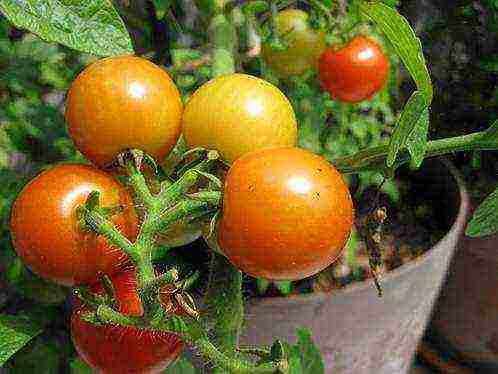
It is quite possible to grow tomatoes on the windowsill in winter. The main thing is to create the necessary light and temperature conditions, as well as to choose the right varieties.
Tomato varieties for growing at home
It is best if these are varieties of low tomatoes with medium-sized fruits. Most often, cherry tomatoes are grown at home. Well, like indoor tomatoes, ampelous and standard varieties show themselves.
If you take the reviews of fans to grow tomatoes at home, then the most favorite variety is Geranium Kiss and Balcony Miracle. They also grow Ogonyok, Snowdrop, Garden Pearl, Siberian Dwarf, Little Prince, etc.
back to content ↑
Lighting tomatoes
When growing tomatoes on a windowsill in winter, the optimal daylight hours are 12 hours, and the best option is 14 hours. At this time of year, this can only be achieved by installing additional lighting over the plants.
The most economical and convenient option is to illuminate tomatoes with LED or fluorescent lamps. How to adapt them - everyone decides individually, the main thing is that it is convenient.

back to content ↑
Indoor tomatoes: growing
Start growing as usual, simply by sowing the seeds in a small container, not in boxes. Since you don't need a lot of seedlings. After all, each plant in the future will need a capacity of about 10 liters, but such "pots" need to be placed somewhere. So calculate in advance how many plants you can fit on the windowsill.
The soil can be taken ready-made, or you can prepare it yourself. To do this, mix one part of humus, sod land and peat, add a liter of sand to a bucket of such a mixture and a tablespoon of superphosphate and ash.
Whether or not to soak the seeds is a personal matter, the emergence of seedlings varies only in 1-2 days.
When the plants have 2 true leaves, transplant them into separate cups. As the tomatoes grow, transplant them into a large container to build up a good root system. If the glass of the plant is small, it begins to grow in height, forming a frail thin stem, and during transplantation, there is a massive root build-up and the stem turns out to be short and thick, which is what we need at home.
Remember that you will not get a harvest in a small pot, be prepared to clutter up the windowsills with large containers of soil. You can, of course, wrap them in some kind of fabric to look more aesthetically pleasing.
But outside the tomatoes in winter on the windowsill look very tempting. On the street there is snow, blizzard, cold, and here little red tomatoes are hanging - beauty ...
Tomatoes should be watered very sparingly, no more than twice a week.
When stepsons begin to grow from the axils of the leaves, they need to be broken off, since when growing at home, we do not need extra shoots.
Check the soil temperature periodically by sticking a thermometer inside it. There should not be much difference with the air temperature. If the windowsill is cold, place styrofoam or some other material under the container with the tomatoes.
If the soil under the plants is fertile, then it is enough to feed the tomatoes during the flowering period and after the formation of ovaries with complex fertilizer for tomatoes.
Those who do not have a garden, but have a love of agriculture, grow tomatoes on the windowsill all year round. In the summer, this, of course, is much easier to do, because you do not need to bother with the temperature and lighting, and tomatoes grow faster in the real sun.
TomatLand6 952 views4 comments
Most viewed on the site
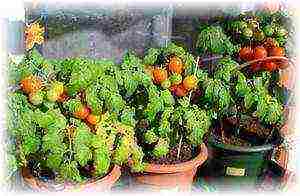 In winter, when a blizzard and cold are knocking on the window, fresh tomatoes on the windowsill seem to be something exotic, unattainable and only more attractive because of this. How realistic is it to grow them in a harsh season? If you know the small nuances of "potted farming", it is no more difficult than ordinary tomatoes in the beds. When there is an insulated balcony, tomato cultivation can be organized on it.
In winter, when a blizzard and cold are knocking on the window, fresh tomatoes on the windowsill seem to be something exotic, unattainable and only more attractive because of this. How realistic is it to grow them in a harsh season? If you know the small nuances of "potted farming", it is no more difficult than ordinary tomatoes in the beds. When there is an insulated balcony, tomato cultivation can be organized on it.
Varieties that will "get along" in the house
All "tomato work" is tightly linked to the availability of free space. If there is enough space on the balcony, you can choose almost any variety for planting - high, low, branched or not very.When only free space on the windowsill is available all year round, cherry varieties or miniature bushes specially bred for "home cultivation", which quickly "give away" the harvest, are suitable for cultivation. Among them there can be both red and yellow varieties of tomatoes. The qualitative composition does not depend on the external color.
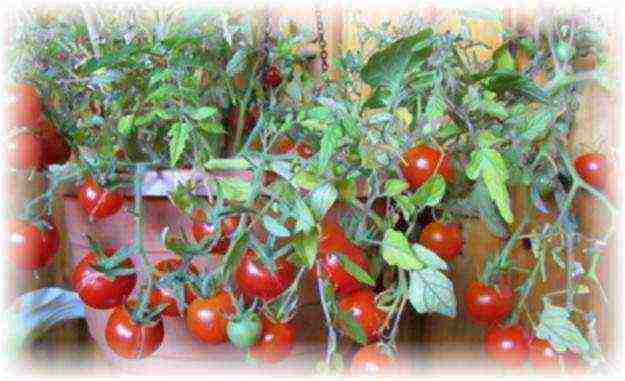 Cherry varieties: Bonsai, Balcony miracle, Baby, Balcony charm, Golden bunch, Chinese indoor, Indoor surprise, Rowan beads, Bullfinch, Japanese dwarf and others.
Cherry varieties: Bonsai, Balcony miracle, Baby, Balcony charm, Golden bunch, Chinese indoor, Indoor surprise, Rowan beads, Bullfinch, Japanese dwarf and others.
Common tomatoes that are suitable for a winter windowsill: White filling, Bull heart, Leopold, Siberian early ripening, Florida Petit, Yamal.
Tomato varieties for balcony cultivation can be taken slightly higher "in growth" and with larger fruits, otherwise the care for them will be the same as for vegetables on the windowsill.
It is important to check the expiration dates, which are always indicated on the seed packaging. Often inexperienced vegetable growers cannot understand why their indoor tomatoes do not sprout in winter. It is quite possible that this is the result of an overdue implementation period.
Miracle on the balcony
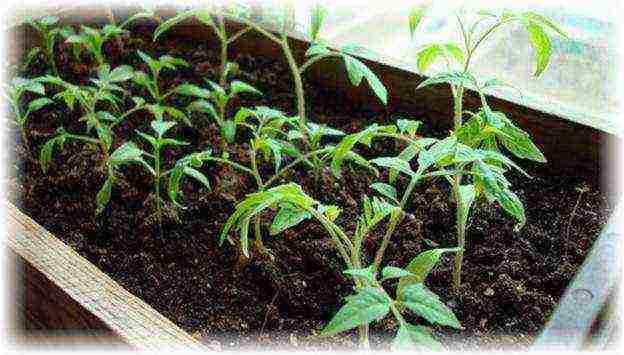 A special love of gardeners "at home" has won the "Balcony Miracle" tomato. This is a compact determinant variety, up to 50 cm high, ultra-early ripening (maximum ripening period of 90 days), the weight of each bright red tomato is up to 65 g, round in shape. The usual yield is up to 2 kg per bush. If the plant is "allocated" a large area, the yield in winter can be higher.
A special love of gardeners "at home" has won the "Balcony Miracle" tomato. This is a compact determinant variety, up to 50 cm high, ultra-early ripening (maximum ripening period of 90 days), the weight of each bright red tomato is up to 65 g, round in shape. The usual yield is up to 2 kg per bush. If the plant is "allocated" a large area, the yield in winter can be higher.
Before germination, the seeds are grown in greenhouse conditions, then the temperature is lowered for a week to 15 degrees, then raised again. When the sprouts rise to 15 cm, they dive into large containers. Tomatoes "Balconnoe Miracle" love light (although they ripen even in conditions of its deficit), do not require tying and removing stepchildren.
A positive effect during winter cultivation will be given: help in pollination, good watering, fertilization, gentle loosening of the soil, and the formation of a bush.
Feeding options:
- Special drugs.
- Liter solution: 5 g of superphosphate, mixed with potassium and urea sulfate - 1 g each.
The most productive top dressing in winter during flowering and fruit formation.
Growing a "Balcony Miracle" house will allow you to collect excellent tomatoes from the windowsill in winter for salads, preparations and even freezing.
Main growing conditions
Growing tomatoes on a balcony or windowsill requires compliance with a number of necessary conditions:
- The best location is at the southern windows. It is practically impossible - in the north.
- Decontaminated, non-clayey soil. Not less than 5 liters per bush.
- On the bottom - drainage with expanded clay or sand.
- Air humidity up to 65%.
- Daylight hours for seedlings are at least 12 hours even in winter, preferably 13-16.
- If necessary, supplement the illumination with lamps installed at least 30 cm from the seedlings.
- Water the tomatoes on the balcony or windowsill carefully, with warm water, without waterlogging, but also without overdrying. On average, every 3 days.
- Air temperature indicators: during the day 25-26 degrees, at night up to 15-16. If it's hotter - ventilate, tomatoes are not afraid of drafts.
- Do not grow on a balcony without insulation before April.
- Loosen the soil and top up if necessary.
- Spraying of leaves, garter of branches is possible.
- Do not turn the pots with bushes so that there is no dumping of tomatoes from the branches.
- It is advisable to install containers on rack supports.
You should not often fertilize tomatoes in winter with nitrogenous and organic fertilizers. Otherwise, powerful, rough bushes with a minimum of small fruits will grow.
Instructions for winter growing tomatoes on the windowsill
 Before you "start" the winter process of growing tomatoes at home, you need to stock up on all the necessary materials. "At hand" should be:
Before you "start" the winter process of growing tomatoes at home, you need to stock up on all the necessary materials. "At hand" should be:
- Seeds of well-known producers with a "fresh" shelf life.
- Sowing cups.
- Containers for planting after picking - "cut-off" bottles, pots.
- Lamps for supplementary lighting.
The main stages of work
- Preparation of containers and tools... "Fry" with a high temperature (in the oven) or treat with a preparation against fungi and bacteria. If new peat pots are used, soak them in a solution of mineral and organic fertilizers and dry them before planting.
- Land preparation. Tomatoes on the windowsill, as in outdoor cultivation, prefer "breathing", clean soil. Ordinary soil can be spilled with hot potassium permanganate, steamed in a water bath, or severely frozen. Examples of mixtures for self-preparation: on an equal part of the earth, humus, peat and sand; on two parts of the land, 4 "measures" of humus and peat, 1 - sand. It is good to spill with a mixture of urea and potassium sulfate, diluting a matchbox by 10 liters of water. Add a handful of ash there. The looseness of the soil is increased by peat or sawdust.
- Germination of seeds. To prevent late blight, soak them in a slightly pink solution of potassium permanganate for half an hour, dry and treat with a growth stimulant. For germination, "wet" the seeds with warm water and leave on a damp cloth in a warm place.
- Sowing rules for varieties for the balcony and windowsill. Sprouted tomato seeds are planted in lightly watered soil in small holes (up to 1 cm), 1 piece each. Dry ones are buried in 2 or 3 copies with a distance of 2 cm. Cover with a film on top or glass is laid and transferred to a warm place, but without "African hell". To harvest tomatoes on the windowsill in winter and early spring, sowing is carried out in October and late November. Continuity of picking tomatoes can be ensured with the following crops in mid-February and late March.
- "Moving" to a permanent place. When shoots have appeared, the covering material is removed, and the pots are rearranged closer to the window. Further, it is important to ensure that the sprouts have enough light and warmth in winter.
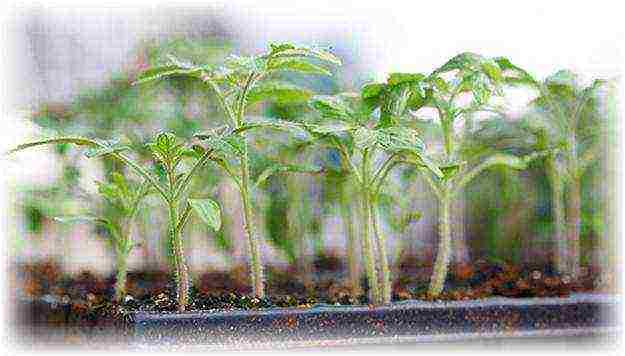 Lift containers with tomatoes from time to time to see if excess moisture has accumulated in the pan. It needs to be removed. Drizzle with water at room temperature.
Lift containers with tomatoes from time to time to see if excess moisture has accumulated in the pan. It needs to be removed. Drizzle with water at room temperature.
- Diving. During the appearance of 2 permanent leaves. After the "procedure" the strongest sprouts receive a more capacious "container" for growth - 7-10 liters. The roots of the seedlings are buried 3 cm, watered. Growing tomatoes on the balcony will take place in such large containers. Larger varieties are immediately tied to pegs. Any tomatoes in the winter after transplanting are not touched for about a week, so that the bushes calmly take root. When it's still cool outside, it is better to bring tomatoes from the balcony into the room at night. With the onset of heat, all landings "move" to the balcony.
- Winter feeding of tomatoes on the windowsill. Seedlings are "supplied" every 10 days with organic matter and ready-made mineral fertilizers. Follow the instructions on the package, remember to gently loosen the soil around the trunk. With the appearance of 2 true leaves, fertilize seedlings with a solution of trace elements in winter. The most important rules of work: for young plants, the dose, reduced by 2 times in comparison with the instructions, is carried out on wet soil, preferably without touching the leaves.
- Stealing and pruning. The stems that begin to grow from the axils of the leaves are called stepchildren. They are removed so as not to take food away from ripening fruits. For the formation of 2-3 stems in undersized varieties, you can leave the appropriate number of stepsons. The rest are removed by hand, preferably in the morning, while there is no strong sun. Low-growing and standard varieties can not be pinned, but the bush can not be thickened either. Sick and yellowed leaves are cut off. After the formation of the brushes, the lower leaves can also be cut off.
You cannot remove all the leaves. In this case, the synthesis of organic materials will be disrupted.
- Bush formation. After fruit setting, 4-5 brushes are left on each trunk. All others are removed along with the top of the stem and inflorescences. When the formation of the fruit itself begins, pinching the top and removing the flowering tassels is carried out.
- Pollination assistance. Tomatoes of "balcony" varieties are also self-pollinating, but help in winter will not hurt them. It is enough to lightly shake the brushes of flowers and tap on the stem. To prevent the ovary from falling off, it is permissible to spray the bush with a solution of boric acid - 1 g per 5 liters of water and add a little potassium permanganate.
- Disease prevention. Without proper care, tomatoes can get sick in winter when grown on a windowsill. If they are "flooded" - mold, rot or late blight are provided. For its prevention, a mixture of the following composition is well suited: half a glass of garlic and a little potassium permanganate (half a gram) are added to a three-liter container of water. Spraying with Fitosporin can be used. The appearance of the whitefly even during winter cultivation on the window is facilitated by soil acidification. The introduction of crumbs of chalk, ash, dolomite flour or slaked lime will help prevent acidification. There are also special deoxidizing preparations.
Responsibly caring for the bushes with all preventive measures, you can be sure that the tomatoes will ripen in the right amount.
Harvesting
To grow a full-fledged crop on the windowsill, it is important to harvest the fruits on time. In winter, the poured tomatoes are removed, which have begun to turn slightly pink. They are laid for ripening on a window or in a dark box. The process will go to the end, and the bush will "throw" all the released nutrients to grow the fruits remaining on the branches.
Knowing how to grow tomatoes at home on a windowsill or balcony, you can pamper your loved ones with “delicious plantings” not only in summer, but also in winter. This will especially delight children, who will examine each plant with the greatest curiosity and will certainly taste small tasty "tomatoes".


